
Scania’s reputation is built on global standards that have their roots in the exemplary Sodertalje facility in Sweden. AMS talks to Production Manager Eric Angquist about the importance of manufacturing know-how
With a turnover of 7,800m and sales of 65,000 vehicles in 2006, Scania is one of the world’s leading manufacturers of heavy trucks, buses, and industrial and marine engines. But past successes and lofty reputations are no guarantee of future success in an increasingly global and competitive environment. At present heavy trucks account for 59 per cent of the company’s sales, buses for 10 per cent, industrial and marine engines for 1 per cent and service-related products for 19 per cent. Its head office is in Södertälje, Sweden, and the company has factories in Europe and Latin America. There are production facilities in Sweden, Poland, the Netherlands, France, Russia, Brazil and Argentina. The company also has assembly operations in another ten countries in Africa and Asia.
During its 116 years of operation, Scania has built more than 1,300,000 trucks and buses, of which more than 500,000 are still in regular operation. The company’s growth has accelerated over years. By 1983, Scania had built 400,000 vehicles. Already in 1987 this had risen to half a million, climbing to 600,000 in 1990 and 700,000 in 1993, while vehicle number 1,000,000 rolled off the production line in 2000. The company’s millionth truck was built in 2002.
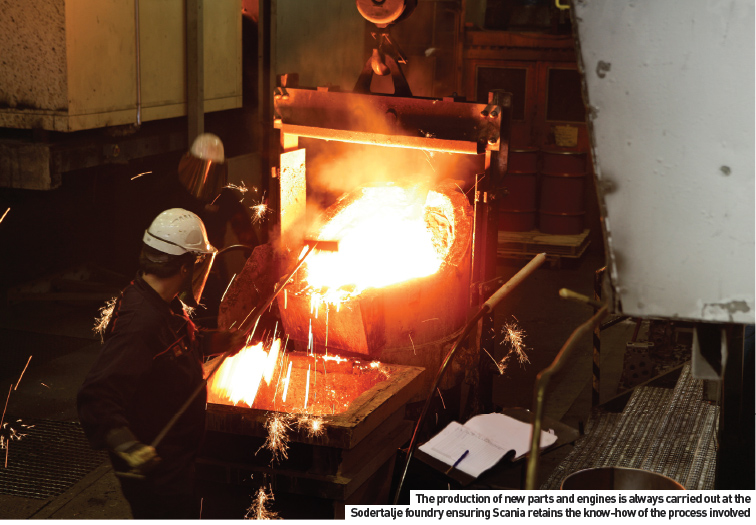 Global standard
Global standard
Scania has a global product and production system. Models and components are interchangeable between factories and continents. Scania’s production methods and environmental standards are the same the world over. This means that bottlenecks in Europe can be avoided by utilising production capacity in Latin America. In this way, Scania was able to fully meet its 2004 expansion plans for its markets in Asia, the Middle East and Africa with vehicles supplied from Latin America while the European factories continued to work at full capacity. The company’s product range is based on a unique modular system that allows a large variety of truck models to be built using a very limited number of components and sub-assemblies. Some components are also shared between trucks and buses. This approach has made it possible for Scania to achieve economies of scale in development and production while retaining its ability to meet strict customer requirements. In theory, using far fewer than 20,000 components, Scania can produce almost two billion variants.
Assembly in Sodertalje
The facility at Södertälje is a huge, sprawling affair south of the town, featuring close on 30 buildings. From initial foundry operations to final assembly, the entire operation is conducted within the confines of the town. But it is the early stages of the process that are the most interesting: the foundry, engine machining and assembly in particular. Within the five buildings that carry out this process they encapsulate much of what is positive about the Scania operation.
For someone more used to the relatively compact proportions of automotive engines, the huge 13-litre inline engines that power its trucks are mind boggling, and make the automation and material handling much more impressive; even modest components such as camshafts take on challenging proportions. The engine foundry and machining employs about 590 people, with an equal number on the assembly lines in two buildings recent purchased from Saab/GM.
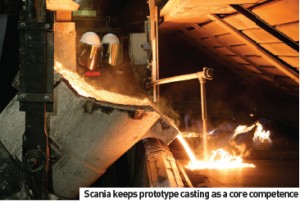 Foundry knowledge
Foundry knowledge
In the foundry Scania produces cylinder blocks and heads, but not the entire volume required; for that it looks to foundries in Brazil and Germany. But the reason behind owning a foundry in the first place is ensuring that, as a company, they retain the knowledge. “We always start the production of a new engine, or a new part, in our foundry here at Södertälje so that we can learn and retain the know-how of the process,” Eric Angquist, Production Manager for Engine Machining, says. “So it is made here at the beginning and then it depends on the volume – if we are in a ramp up or ramp down phase. It changes all the time but the basic idea for our foundries is providing high quality blocks and heads and developing the process and geometry of the blocks and heads in new engines.
“Retaining knowledge is important to us. The combustion chamber and the strategic components – they are components that we can give away, we don’t see them as important as the others. We try retaining a lot of experienced people that have been working for 20, 30, 40 and even 45 years. We also value the experience of our retired employees by retaining them on consultant contracts. If we have problems we ask for them to advise us and help train the junior staff. We try to look at the history and try to do something that no one else is doing; if you can add something extra for the customer then you need the knowledge to do it.”
Clean machining
Apart from the sheer size of the operation there are three things that you notice when entering the machining hall. The first is the general cleanliness, the second is the pride with which the operatives go about their job. Thirdly and I’m sure core to what they are trying to do, is the ease of view – or “visualisation” in Scania parlance. The open feeling is aided by the extensive use of overhead conveyors, which allow workers to see the entire line, including sight of takt boards and warning lights.
In typical Scania configuration, the camshaft line – really two lines as it is broken by an external heat treatment hardening operation – is a parallel operation, composed of two identical flow lines. An ABB robot presents the forging to the GSA gantry loading conveyor system and through a series of milling operations (Heller) and turning centres (Heyligenstaedt). The part is moved between operations by the overhead conveying system, keeping a clear line of sight and at the end of the flow is stacked by a second ABB robot. The two lines are manned by operatives and can produce 110 camshafts in each of three daily shifts. “We run parallel lines which enables us to run production with a very high up-time,” Angquist explains. “It also enables us run prototypes in the same flow, and to be able to ramp up new products and ramp down old products without any big changes to the tooling. We try to use the same structure in all operations.
B uffers and flows
uffers and flows
“We like to work in real time, with visualisation and standardised work, and a flow all the time,” continues Anquist, “but we also had to accept that we still need buffers on specific areas and we need to have an amount of flexibility. We have gantry loaders, but we have the cranes so that we can run prototypes, so we have an amount of flexibility.
“An important thing is to be able, with smaller investments, to go further on in the same production stretch. Of course, with a new generation of grinders or something we can use the same buildings, we can use the same gantry loaders, and we can use the same robots. These really are the basics.”
As Angquist explains, the buffer, half a dozen loaded pallets that currently sit on the floor between the soft and hard (unhardened and hardened) camshaft lines, is a necessary evil at present. It is something that they are working hard to eradicate by bringing in-house the hardening process. “Many of our competitors they have had it for many years,” he says. “We have a unique hardening method, but the disadvantage is that we have to have a nice flow to run the hardening in batches and its outside in a different building, so it slows the process down.” On occasion buffers are something that can’t be helped when the product flow is interrupted by an external operation that cannot be accomplished in-house – either for technical or financial reasons. “You do that if you really fail, but you should really avoid that. The flow is extremely important – without the flow you don’t have any takt, you don’t have any standardised work, you lose real time feedback and visualisation and you get a lot of waste. But maybe in a start-up phase, if we had a new method running on a very low level, that’s something else. We implement a strategy to bring the production in-house if it is important for the core business. Otherwise we send it out. If it is important for the combustion chamber – longterm knowledge – then we would keep it.”
Crankshaft contrast
The hard camshaft line is in effect a mirror of the soft line, with ABB robots loading a Bleichert overhead conveyor that takes the part through grinding, polishing and superfinishing machines using Landis and Junker grinders. At the end of the line, clearly visible by all workers on both camshaft lines, is a huge takt timeboard showing the quantities expected for the shift and any discrepancy. On the crankshaft line there are a lot of alterations going on as the process is updated. But in its transient stage it provides an ideal contrast between the old and the new. The old line, transferred between machines by robots, looks messy and it is impossible to understand what is happening along the entire line.
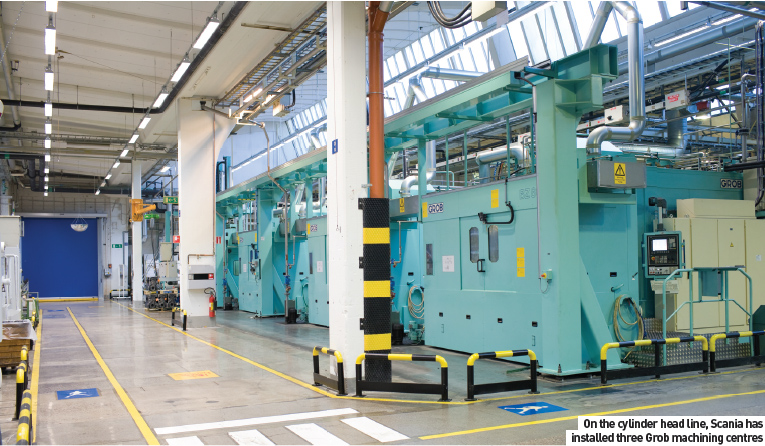 On the new lines however, three parallel flow lines utilising GSA conveyors are clearly discernible and the entire process, through Alfing hardening machines and Junker and Landis grinders, can be seen from anywhere on the line. “You can see the difference,” Angquist explains as we strolled the lines. “That was the way we built at the beginning of the nineties and the way some people still build today. The most important thing is team work. When you are talking about spirit you need visualisation and real time, and you need to see happy faces. You can see the staffguys are happy and they didn’t know that you were coming.”
On the new lines however, three parallel flow lines utilising GSA conveyors are clearly discernible and the entire process, through Alfing hardening machines and Junker and Landis grinders, can be seen from anywhere on the line. “You can see the difference,” Angquist explains as we strolled the lines. “That was the way we built at the beginning of the nineties and the way some people still build today. The most important thing is team work. When you are talking about spirit you need visualisation and real time, and you need to see happy faces. You can see the staffguys are happy and they didn’t know that you were coming.”
Replacing old lines
As for the cranklines themselves, Angquist explains that it is the same concept as on the camshaft lines. “We are running with three parallel flows in the soft machining and at the moment we have three hardening machines; two from Alfins and one from Ellaton. We will throw the oldest one out because it is really old. “The concept here is flow, its visualisation, its takt. You can see the difference between a robot line and a gantry line and, of course, it is an old robot line. But you will still see the difference and you will understand why we put a little extra money into the gantry line because it improves the flow in real time. We will have a better output and happy people there. “There are three lines there and a hard line, the grinders in the beginning and the balancing and polishing, and the final inspection. For the in-line six and the V8, we have some special operation assembling the counter weights and so on.”
One good example of the pride of the workforce is their attitude during what is an unsettling time as old lines are replaced by new – the hall in places resembles a building site – all without slipping on production targets. “We do the changeovers while we are running what are extremely high levels of production,” Angquist says. “For the people it has been terrible sometimes, but they have been participating in the new lines and see the way it has been done and they know it’s worth it. “It’s hard to believe that someone can work next to an excavator. We do worst things at weekends, but we are running almost 365 days so we don’t have any extra time to wait for vacations and things like that.”
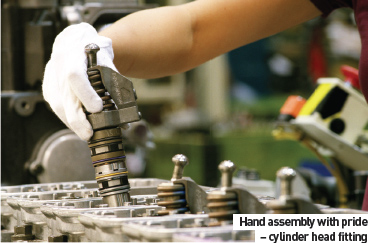 Blocks and heads
Blocks and heads
Moving across to the block and cylinder hall is quite a contrast. Here you are faced with a huge traditional transfer line, with close to 30 machine tools each carry out unique operations machining the cylinder block before moving the part along a floor conveyor to the next tool. In an attempt to increase the line’s flexibility three modern and versatile MAG Hüller Hille machining centres have been added in the middle of the process. The same is true for the smaller cylinder head line, where three Grob machining centres have been added. “We have two rigid old fashioned lines with a low level of flexibility,” Angquist says. “We were running one engine programme, but now we have started a new engine programme and we need to be able to run these products as well. Then we added three machines in the D12 cylinder block line and three machines in the cylinder head line. “This gave us the flexibility for the new products, but also allows us to make product improvement in the old engine family as well. So we have a good mix and in the new lines we are building up we have a mix. The machining centres form the base there but we will also have special machines. Like the rest of the world though, we are moving to machining centres. This will allow us to have a very high level of flexibility for new engine programmes and changes in the current engine programme. So it gives us flexibility and we also work really hard with the standardisation of components.”
Conrod and liners
A short walk brings you to the third hall of the machining process, where the conrods and cylinder liners are machined. Scania have adopted an entirely different method for conrod manufacturing, opting for one-hit Emag machining centres loaded by ABB robots. The parts are moved from these machining centres by forklift trucks, a rare sight in the factory, on to a Mollart oil-drilling machine, and Alfing cracking machine before finishing at a Mauser boring centre. As Angquist explains, this one-hit machining layout gave the company an easy path to increase production. “At the moment we have three machining centres and we are installing a fourth,” he says. “These four cells will be totally in parallel and they all do the same work. The good thing is that we started out with one where we tried the concept – just one machine, one robot. Then we added one more and one more until the fourth. We can add more machines as well. It gives us the possibility to improve the method and work in steps and invest.
“We will do the same in the three new lines we are building. We are installing one step and we are prepared for step two and we are prepared for step three. So we can run in the same structure and thinking about new concepts. With these machining centres you get something more. With the conrod line, we run it with parallel cells and a small buffer and then we go to a smaller line with oil hole drilling and a cranking machine, then a small buffer and then we go into a fine boring machine. We are running that line at a very high level of up time and we will have the possibility to run many different kinds of conrods; we can run prototypes as well.”
Benchmarking from the beginning
Angquist is rightly proud of the productivity that he has achieved at Sodertalje, but on that productivity, like most other companies Scania carries out extensive benchmarking – both on a cost per part basis and over processes. “We are always running studies where we compare with other suppliers,” he explains. “We go really deep into the figures and then we see that we are running on a good level; talking about cost per component of course.
“We always need to keep the organisation on its toes because you can never relax. The competitive situation in our industry will not get easier; it will get harder and harder every year. Now we have the Asians coming up so we have to stay competitive and we work hard in order to achieve that. Otherwise someone else will do it for us. “We run our strategic products and we try to keep the knowledge and develop our knowledge together with our suppliers. We are looking at the price per unit of course, but if the know-how is important then we accept a higher price per unit cost, at least in the beginning.”
Scania schooling
To maintain such a level of productivity it is vital that the company has a stream of new recruits, and for this Scania have a very successful training school. “We have one of the two oldest schools of this kind in Sweden; the other is the ABB Technical College,” Angquist says. “Each year we have two classes with about 25 students in each. We employ 50 youngsters every year, about 16-17 years old. They are employed from the first day and in addition to learning English, Swedish, Mathematics, they learn about the job. So they learn about CNC, mechanical engineering and so on. I think you have things like this in the UK and I a
m sure that I have seen similar in Germany. The numbers applying for the programme is between 200-300, so we get a very nice levckel of shop floor people with the ability to grow into managers. It is very important.”
State-of-the-art assembly
Half a mile up the hill is the engine assembly buildings, recently purchased from GM, and, although very similar to automotive engine assembly, it is still impressive – notably for its state-of-the-art conveying system. After travelling along a traditional preparation line the engine is loaded by ABB robot onto its own monorail station on the TMS Variolift overhead conveyor line.
As it snakes its way back and forth along the factory, this monorail can lift and tilt to present the engine to the operatives at just the right angle. In addition, each monorail carries a monitor that displays all of the engine’s instructions. Along the floor each station is clearly marked, and a red laser guider projects down from the carrier highlighting exactly where the engine is in the process and warning the operator of any shortage in time.
The takt time for the line has been reduced from three minutes 48 seconds per operation to three minutes 15 seconds in just 12 months, and further improvements are planned. It should be noted that these improvements are worker driven, with loading boards on white boards at various stations showing ideas for optimum loading. The entire facility at Södertälje,is impressive and it needs to be if the company is to fight off competition from low cost economies. But backed by a workforce that has great pride in the company, its products and the processes have a strong foundation for any future challenges.
Every manufacturing factory you visit has its own methodology for increasing productivity and quality – but in truth they operate with widely differing results. Scania has adopted the Scania Production System (SPS), based on Toyota Production System (TPS), and aided by visits to Toyota. The impressive thing about SPS is not how simple its methodology is, or how well they have adopted the Toyota way of thinking, but the way it has been adopted by staff throughout the organisation. Throughout the visit to Sodertalje the pride that the workers take in what they are doing goes beyond the norm.
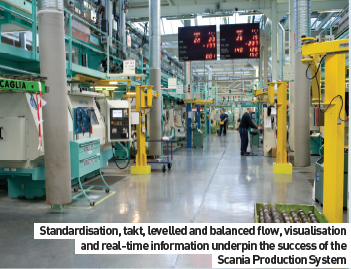
Based on the core values of pride, trust and respect Scania has an excellent foundation to realise standardisation, takt, levelled and balanced fl ow, visualisation and real-time information. “We call it our Scania House,” says Angquist. “I think it gave us the opportunity to really show, on one piece or paper, the whole Scania culture. When you talk about elimination of waste, we don’t give money away, we keep our money. “Also on the customer side, it is always the customer fi rst. We spend a lot of time talking about the end customer. In our daily work we have our internal customer but I know you see that in many companies. What I see is that respect for the individual is a cornerstone of our success. The way we try to treat people, the way we expect people to behave in the work teams, and the way we try to treat people when we are making the changes; respect is crucial.
“It is about involvement and commitment. It is all about pride and trust. We have principles – anyone who visits Scania will see them. Real time targets, visualisation, balance and level flow – all these are principles supporting the standardised work and these are the pillars that support the house. For me it is obvious – it is strongly connected to customer first, but also to the core value and respect for the individual and for elimination of waste, as well as quality.”
All of this leads to the four priorities for Scania – safety, quality, delivery and cost. “We spend extra money on safety because we know it is strongly linked to respect for the individual and encourages the commitment you get from people; it’s very easy to say but you have to show it,” Angquist adds. “So, as a company, we lead the way in safety, and in many cases we are years ahead of the new standards that are coming out. We are participating in the new security standards in Europe and, while this adds some extra cost, at the same time we are running our equipment for two decades, even 25 years. We really try to start on a high level.
“So you have safety, quality and delivery – and then you have cost. If you have everything under control, starting with the safety, it will help the cost. But if you start with the cost you get lost and start making stupid decisions; good in the short term but really bad in the long term. With that type of thinking we wouldn’t have any technical high schools and we wouldn’t have any long-term development.
“It’s basically what we learned when we sent managers to Japan in the ‘80s or ‘90s. Toyota allowed us to see their company culture, but as you see they are far in front of us. We have many things to learn, but we are improving.
“Being in the truck industry it is not so bad; it is good.”


































